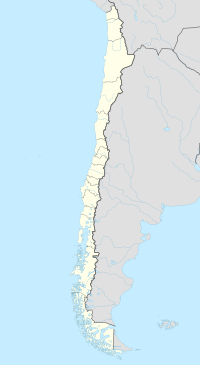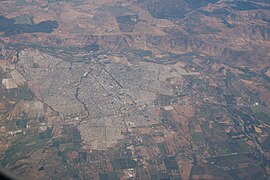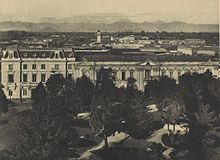Talca
| Talca | |
|---|---|
|
Coordinates: 35 ° 26 ′ S , 71 ° 40 ′ W
Talca on the map of Chile
|
|
| Basic data | |
| Country |
|
| Residents | 220,357 (2017) |
| - in the metropolitan area | 249,744 |
| City insignia | |
| Detailed data | |
| surface | 232 km 2 |
| Population density | 950 people / km 2 |
| height | 102 m |
| Waters | Río Claro |
| Time zone | UTC −4 |
| City Presidency | Juan Carlos Díaz Avendaño (since 2016) |
| Area: s. Congress statistics | |
| Aerial view | |
Talca [ ˈtalka ] is a city in Chile , capital of the province of the same name Talca and of the VII. Region of Chile, the Región del Maule .
Talca is located on the Panamericana in the middle of a fertile plain characterized by wine and fruit growing , about halfway between the Pacific coast and the Andes cordillera . The city and its surroundings have a relatively rural character.
population
According to the 2017 census, the municipality of Talca has 220,357 inhabitants (2002: 201,797), of which 9,447 residents live in the rural outskirts in the outskirts of the city. Since Talca has expanded rapidly in recent years and has merged with the neighboring municipality of Maule in the south , a total of around 250,000 people live in the urban agglomeration of Talca. Together with the satellite town of Culenar, which is already on the arterial road in the area of the municipality of Maule, the population of the closed settlement core of the town of Talca is also given as 237,295.
Geography and climate
Talca is about 250 km south of the capital Santiago . The Río Claro flows through Talca and later flows into the Río Maule . The city is located in a basin formed by the valleys of these rivers and is surrounded by hills.
The climate is Mediterranean with warm summers from November to April. Winters are rainy and cool, but snow rarely falls in Talca.
There are many wineries and agricultural processing plants in the surrounding area. The Pacific coast can be reached in less than an hour by car. To the east, the primeval natural forests of the Andean foothills begin at some distance. The high mountain panorama of the Andes Cordillera is visible from every point in the city.
The region forms the climatic transition between the warmer and dry north and the cold and rainy south of Chile. In this zone there is therefore a particularly diverse flora and fauna.
history
Talca was founded in 1692 by Governor General Tomás Marín González de Poveda . On February 17, 1742 it was named Villa San Agustín de Talca from Governor José Antonio Manso de Velasco . On June 6, 1796 it received city rights.
Talca is also home to the house where Bernardo O'Higgins signed the proclamation of Chile's independence on February 12, 1818, the first anniversary of the Battle of Chacabuco . Before that, Ramón Freire y Serrano had taken the city. The historic building is now a museum.
The political climate in Talca has been considered liberal and rebellious since the days of the War of Independence, which made the city the scene of protests and riots on various occasions, especially during the so-called "authoritarian" regime of conservative presidents from 1831 to 1891. During the riots of 1851 Talca was forced into submission by foreign government supporters under the militia leader José Joaquín Vallejos . Talca also joined the liberal uprising against the central government that broke out in the provinces in early 1859. Unlike in northern Chile, where 5,000 people fell victim to civil war-like fighting, the military Eleuterio Ramírez Molina succeeded in suppressing the uprising in Talca bloodlessly and quickly ending it with the measures imposed on February 22, 1859.
On December 1, 1928, Talca was struck by a severe earthquake in which around 100 residents of the city died.
In the earthquake on February 27, 2010 , large parts of the historic city center were badly damaged or destroyed. There were fatalities in Talca and the city's hospital, which was largely in danger of collapsing, had to be closed.
About 90 km south of the city is the notorious German-speaking settlement Colonia Dignidad .
Attractions
Before 2010, colonial-style houses could be found all over the city . The house in which Bernardo O'Higgins signed the proclamation of Chile's independence in 1818 is now the Museo O'Higginiano y de Bellas Artes .
Talca is the starting point for excursions to the surrounding region and to Vilches , a park in the Andes . The Pacific coast can be reached by a slow train.
Around Talca there is a tranquil country idyll with many natural beauties in a small area, wineries, hilly forest and cultural landscapes in front of the impressive high mountain panorama. There are also haciendas from colonial times in the area around the city, which were home to the Huasos , a kind of Chilean cowboys or gauchos .
economy
Wine, fruit and vegetables are grown around Talca . The weekly market in Talca, where farmers from the region sell their products, is one of the most famous producers' markets in central Chile.
The city is located on the Panamericana , the main highway that crosses Chile from north to south. The road in this area of Chile is built like a motorway.
In Talca there are several canning factories and other industrial settlements, a university and three newspapers, El Maule, La Prensa and El Centro . The economy is particularly characterized by businesses that process agricultural products.
Personalities
Sons and daughters:
- Agustín Abarca (1882–1953), Chilean painter
- Nicolás Andrés Córdova (* 1979), Chilean football player
- Armando Donoso (1886–1946), essayist, journalist, editor and literary critic
- Don Francisco (* 1940), Chilean television presenter
- Nicanor González Méndez (1864–1934), painter
- Pedro Opazo (1876–1957), Chilean politician, interim president for one day, 1931
- Samuel Parot (* 1963), show jumper
- Aurelio Silva (1866–1923), Chilean violinist and music teacher
- Raúl Silva Henríquez (1907–1999), Archbishop of Santiago de Chile and a cardinal of the Roman Catholic Church
See also
swell
- ↑ a b c Municipal statistics of the Chilean National Congress , accessed in August 2018.
- ↑ Alcalde de Talca inaugura año escolar 2018 en Liceo Industrial de la capital Maulina. In: El Diario de Maule , March 6, 2018; Vita (self-presentation) ; both accessed on September 19, 2018.
- ↑ a b Query on the portal of the 2017 census of the Chilean statistical institute INE, accessed in August 2018.
- ↑ According to citypopulation.de , accessed in August 2018.
- ↑ https://www.theguardian.com/world/2010/feb/28/hundreds-feared-dead-chile-earthquake
- ↑ http://www.nytimes.com/2010/03/01/world/americas/01chile.html?pagewanted=2&hp
Web links
- official website (spanish)








